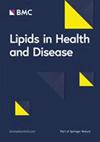Beneficial effects of linoleic acid on cardiometabolic health: an update
IF 3.9
2区 医学
Q2 BIOCHEMISTRY & MOLECULAR BIOLOGY
引用次数: 0
Abstract
Linoleic acid (LA), as a part of the wider debate about saturated, omega-6 and omega-3 fatty acids (FAs) and health, continues to be at the center of controversy in the world of fatty acid research. A robust evidence base, however, demonstrates that higher intakes and blood levels of LA are associated with improved cardiometabolic health outcomes. LA lowers total and low-density lipoprotein cholesterol when compared with saturated fatty acids and carbohydrates. Using large prospective datasets, higher blood levels of LA were associated with lower risk of coronary heart disease, stroke and incident type-2 diabetes mellitus compared with lower levels, suggesting that, across the range of typical dietary intakes, higher LA is beneficial. Recent trials of LA-rich oils report favorable outcomes in people with common lipid disorders. However, an LA intake that is too high can impair endogenous synthesis of eicosapentaenoic acid (EPA) from alpha-linolenic acid (ALA), but the threshold at which this becomes clinically relevant is not known. In the absence of a significant intake of EPA and docosahexaenoic acid, an ideal dietary ratio of LA and ALA may be theoretically useful as it provides insight into the likely extent of endogenous EPA synthesis from ALA. Updating dietary reference intakes (DRIs) for LA and ALA is needed; however, there are insufficient data to establish RDAs for these fatty acids. The omega-6 (n-6) to omega-3 (n-3) PUFA ratio is not informative and does not shed meaningful insight about the amount of individual fatty acids in each class needed to confer health benefits.亚油酸对心脏代谢健康的益处:最新进展
亚油酸(LA)是有关饱和脂肪酸、ω-6 脂肪酸和ω-3 脂肪酸与健康的广泛争论的一部分,在脂肪酸研究领域仍然处于争议的中心。然而,有力的证据表明,较高的 LA 摄入量和血液水平与心血管代谢健康状况的改善有关。与饱和脂肪酸和碳水化合物相比,LA 可降低总胆固醇和低密度脂蛋白胆固醇。通过使用大型前瞻性数据集,与较低的 LA 水平相比,较高的 LA 血液水平与较低的冠心病、中风和 2 型糖尿病发病风险相关,这表明在典型的膳食摄入量范围内,较高的 LA 水平是有益的。最近关于富含 LA 的油类的试验报告显示,对患有常见血脂紊乱的人有良好的疗效。不过,LA 摄入量过高可能会影响由α-亚麻酸(ALA)合成二十碳五烯酸(EPA)的内源性合成,但这一现象与临床相关的阈值尚不清楚。在没有大量摄入 EPA 和二十二碳六烯酸的情况下,LA 和 ALA 的理想膳食比例在理论上可能是有用的,因为它可以让人了解从 ALA 合成 EPA 的可能内源性程度。需要更新 LA 和 ALA 的膳食参考摄入量(DRIs);但是,目前还没有足够的数据来确定这些脂肪酸的 RDAs。ω-6(n-6)与ω-3(n-3)PUFA 的比率并不具有参考价值,也不能说明每类脂肪酸中对健康有益的单个脂肪酸的含量。
本文章由计算机程序翻译,如有差异,请以英文原文为准。
求助全文
约1分钟内获得全文
求助全文
来源期刊

Lipids in Health and Disease
生物-生化与分子生物学
CiteScore
7.70
自引率
2.20%
发文量
122
审稿时长
3-8 weeks
期刊介绍:
Lipids in Health and Disease is an open access, peer-reviewed, journal that publishes articles on all aspects of lipids: their biochemistry, pharmacology, toxicology, role in health and disease, and the synthesis of new lipid compounds.
Lipids in Health and Disease is aimed at all scientists, health professionals and physicians interested in the area of lipids. Lipids are defined here in their broadest sense, to include: cholesterol, essential fatty acids, saturated fatty acids, phospholipids, inositol lipids, second messenger lipids, enzymes and synthetic machinery that is involved in the metabolism of various lipids in the cells and tissues, and also various aspects of lipid transport, etc. In addition, the journal also publishes research that investigates and defines the role of lipids in various physiological processes, pathology and disease. In particular, the journal aims to bridge the gap between the bench and the clinic by publishing articles that are particularly relevant to human diseases and the role of lipids in the management of various diseases.
 求助内容:
求助内容: 应助结果提醒方式:
应助结果提醒方式:


